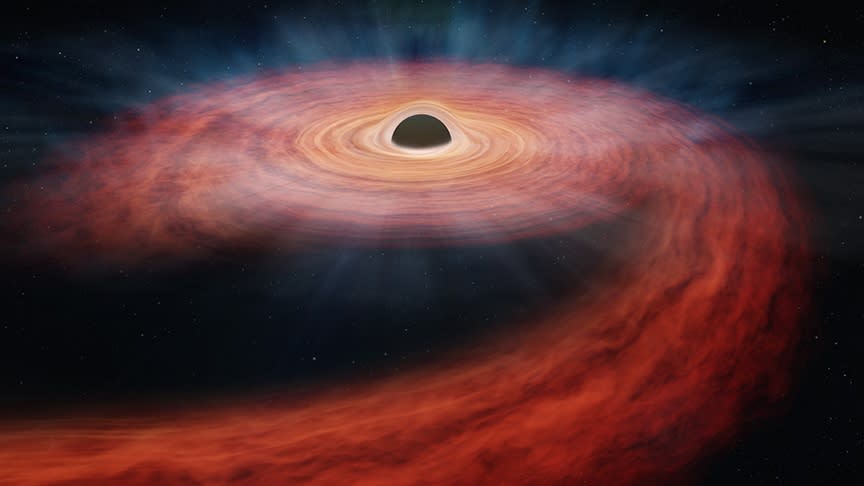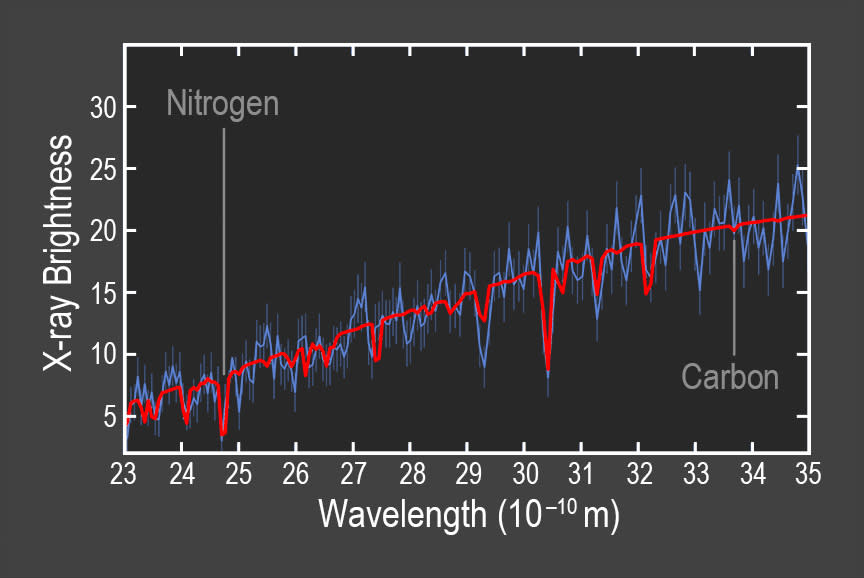Supermassive black hole chews up huge star, spits stellar 'guts' into space (video)

On Tuesday (Aug. 22), scientists announced they might have found evidence of the most massive star ever seen ripped apart by a black hole — and the behemoth charged with this crime appears to have literally tossed its stellar victim's insides into the darkness of space.
"We are seeing the guts of what used to be a star," Jon Miller of the University of Michigan, who led a study on the findings, said in a statement. "The elements left behind are clues we can follow to figure out what sort of star met its demise."
Such elemental analysis led the team to believe that the ravaged star once harbored about three times the mass of our sun, meaning it is only rivaled for its title by a glimmering beast associated with something known as the "Scary Barbie" event reported earlier this year. Scary Barbie is the name given to a possible cosmic affair in which a star with a staggering 14 times the mass of our sun was obliterated by a black hole. For context, the sun's mass is 333,000 times that of Earth. But there's considerable uncertainty surrounding the Scary Barbie event, as you'll see below.
The recently studied event, dubbed ASASSN-14li, sounds much more formal than Scary Barbie. And, unlike the Scary Barbie star, there's considerable proof of the ASASSN-14li object's size, thanks to new information gleaned from NASA's Chandra X-ray Observatory and the European Space Agency's XMM-Newton. To be clear, however, ASASSN-14li was first discovered in 2014.
"Observing the destruction of a massive star by a supermassive black hole is spellbinding because more massive stars are expected to be significantly less common than lower-mass stars," Enrico Ramirez-Ruiz of the University of California, Santa Cruz, a co-author of the study, said in the statement.
Related: Black hole jet surprises scientists with 'peculiar' radio signal

"These X-ray telescopes can be used as forensic tools in space," fellow co-author Brenna Mockler, of Carnegie Observatories and the University of California, Los Angeles, said in the statement.
Events like ASASSN-14li and Scary Barbie, which involve a black hole that terrorizes a star, are called tidal disruption events, or TDEs. According to the press release, as a black hole's gravitational forces start impacting a misfortunate star that got too close, a flare emitting optical, ultraviolet and X-ray wavelengths is sent out. This flare happens in conjunction with the star's debris heating up.
So, the researchers employed their two powerful instruments to study those TDE-rooted wavelengths and figure out the concentrations of elements surrounding the black hole in ASASSN-14li, which sits some 280 million light-years from Earth. In doing so, they parsed the ratio of nitrogen to carbon present at the cosmic crime scene with stunning detail.
And most importantly, that observed ratio seemed to be in line with what's expected to lie within the interior of a star about three times more massive than the sun, Mockler explained.
From there, the team reasoned that what they've been studying is actually the "guts" of a doomed star with those dimensions, caught in the grips of a supermassive black hole.
These findings contrast with previous work, published in 2017, which suggested the star in ASASSN-14li held something like 0.6 times the mass of our sun. In fact, some other studies, the team points out, even suggested the gas surrounding ASASSN-14li's black hole wasn't associated with a single star at all, but rather stemmed from a bunch of eruptions spit out from the void itself.
"ASASSN-14li is exciting because one of the hardest things with tidal disruptions is being able to measure the mass of the unlucky star, as we have done here," Ramirez-Ruiz said.

Related Stories:
— Was Oppenheimer, the father of the atomic bomb, also the father of black holes?
— The loneliest monster black holes may also be the hungriest
— Colliding black holes could hide in the light of superbright quasars
But, perhaps Scary Barbie's star will live up to its wrestler-sounding name and eventually take the cake. Right now, the only evidence we have of this hefty stellar object comes from the brightness of its flare, not exactly the chemical composition of it. Maybe best to live in bliss, assuming the world in which gargantuan black holes rip apart 14-solar-mass stars may not be the one we're in.
A paper on these findings was published in the Aug. 20 issue of The Astrophysical Journal Letters.

